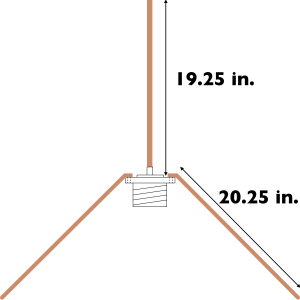The first antenna that you should consider building is the quarter-wave ground-plane antenna for the 2m band. They are very easy to build and will perform better than the antennas that come with most handhelds.
The quarter-wavelength, ground plane antenna is made up of one vertical element, called the driven element, and four radials. The radials make up the ground plane. An easy way to make this antenna is to use an SO-239 coax connector. The driven element is soldered directly to the center conductor, while the four radials are connected to the four holes in the connector’s flange. See the figure at right.
Now, let’s calculate how long the elements should be. Since the wavelength of a radio wave is equal to 300/f (MHz), one quarter wavelength will be equal to 75/f (MHz). At 146 MHz, therefore, the length of the driven element is:
75/146 = .51 m
In practice, we have to make one more adjustment. Because a radio wave travels more slowly in a wire than it does in free space, the wavelength will actually be about 5% less in a wire than in free space. So, we multiply the wavelength in free space by .95 to get the length of the driven element:
.51m x .95 = .49m = 19.25 inches
The radials should be about 5% longer than the driven element. This isn’t really very critical, so if you make them 20.25 inches long, the antenna will work just fine.
You should make the elements out of a stiff wire. 12 AWG copper wire will work for experimentation purposes. Welding rod might be better for a more permanent antenna.
You need to solder the 19.25-in. driven element to the solder cup of the center conductor of the SO-239 connector. Attach the radials to the holes in the flange of the SO-239 connector with nuts and bolts. You can also use these nuts and bolts to mount the antenna to some kind of bracket. Bend the radials out to a 45-degree angle, connect a coax cable to it, and start having fun

No comments:
Post a Comment